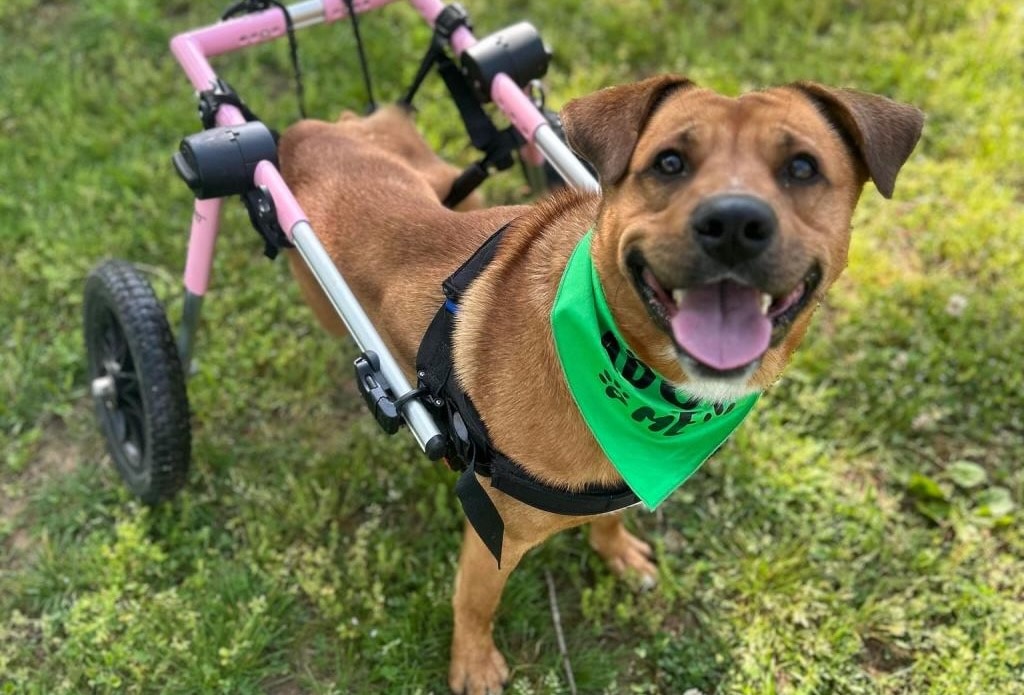“After the hit and run, he’d pulled himself to safety under the car, and we had no way of knowing how long he’d been out there,” said Lauren Mann, the animal shelter’s director of advancement.
The dog had a spinal cord injury, leaving him unable to use his back legs — or wag his tail.
He was treated for his injuries, and fitted for a canine wheelchair they had at the shelter. He took to it as soon as he was strapped in.
Mann and other shelter employees named the black-and-brown mixed breed “Ward the Wunderdog” because of his resilient nature and sweet demeanor, she said.
Once Ward gained some strength, they listed him for adoption and took him for regular physical therapy sessions at a local veterinary clinic that offered free hydrotherapy sessions for injured shelter dogs.
Ward enjoyed his weekly time on a treadmill inside a glass tank that gradually fills with water, Mann said. After several months, the shelter’s veterinary team noticed him trying to flex his back leg muscles while he was roaming around outside in his wheelchair.
“It was like he was trying to run with his back legs, even though they were suspended in the chair,” she said. “He was getting stronger despite his paralysis.”
Still, nobody seemed interested in adopting the friendly 6-year-old canine, Mann said.
Then on July 11, a woman who works as a physical therapy assistant went to a Bissell Pet Foundation adoption event and saw Ward. She was immediately smitten.
Kellyn Murphy said she and her husband Matt Murphy knew they wanted him. Where other people saw a paralyzed dog who couldn’t even wag his tail, Murphy saw a loving face and a lot of potential.
“As soon as I saw him, it became my goal to get him moving and standing,” she said. “I spend my days helping people do these things, and I thought I could also help Ward.”
Kellyn Murphy hoped he’d be a fit with their three other dogs, adding that special needs animals are often overlooked, but can make great pets.
“We took him home for the night for a slumber party to make sure all of the dogs meshed well, and Ward got along great,” she said. “He was just so sweet that we knew we had to keep him.”
Murphy, 38, started doing daily stretching sessions with Ward, gently moving his paralyzed back limbs for a few minutes at a time. She continued taking him to hydrotherapy treatments and for walks in his wheelchair. She also modified an adult-sized walker she’d picked up at a local thrift shop, so he could practice standing up.
“I attached some outdoor chair fabric and made a little sling for him to rest his hips on while he practices standing for about two minutes at a time,” she said.
Less than two weeks after taking Ward home, Murphy saw Wade lying on the floor one morning chewing a bone. Then, in what seemed like a miracle, Ward wagged his tail.
“It was a small wag, and it was only one wag, but it was definitely a wag,” she said.
Dogs’ tails are often an indicator of their emotions, whether they are wagging them, holding them high in the air or tucking them down low.
Murphy believes Ward was wagging out of happiness, and the following day he did it again as he played with Bucket, one of his dog buddies. Murphy said she knew he was slowly gaining back some of his range of motion, and his ability to communicate in the age-old canine way.
“He’s wagged his tail at least five or six times since then, and I’m hopeful it will continue to keep happening as he gets stronger,” Murphy said.
Her dog has also taken two steps on his own while propped up in his walker frame.
Ward wears doggy diapers around the house, she said, but lately she has noticed him showing more bladder strength.
“We’ll help stand him up and a lot of times, he’ll just choose to relieve himself then,” she said.
Although Ward likes to slide around on his belly, he moves especially fast and gets excited when she rolls out his wheels for walks outside, Murphy said.
“When you put his harness on, he bounces all over the place and his whole face lights up,” she said.
Murphy recently started a Ward the Wunderdog Instagram page for her pup, so people can follow Ward as he grows older and perhaps regains more of his mobility.
She continues to help him with leg stretches every day, and she is now looking to have some special splints made for his feet, so he can stand for longer periods in his walker.
Her long-term goal is to train Ward to become a therapy dog so he can visit adults and children struggling with their own mobility issues, Murphy said.
“He’s fun-loving, determined and incredibly calm, and he brings a lot of joy to everyone who meets him,” she said. “I think he’d be a natural at it.”
